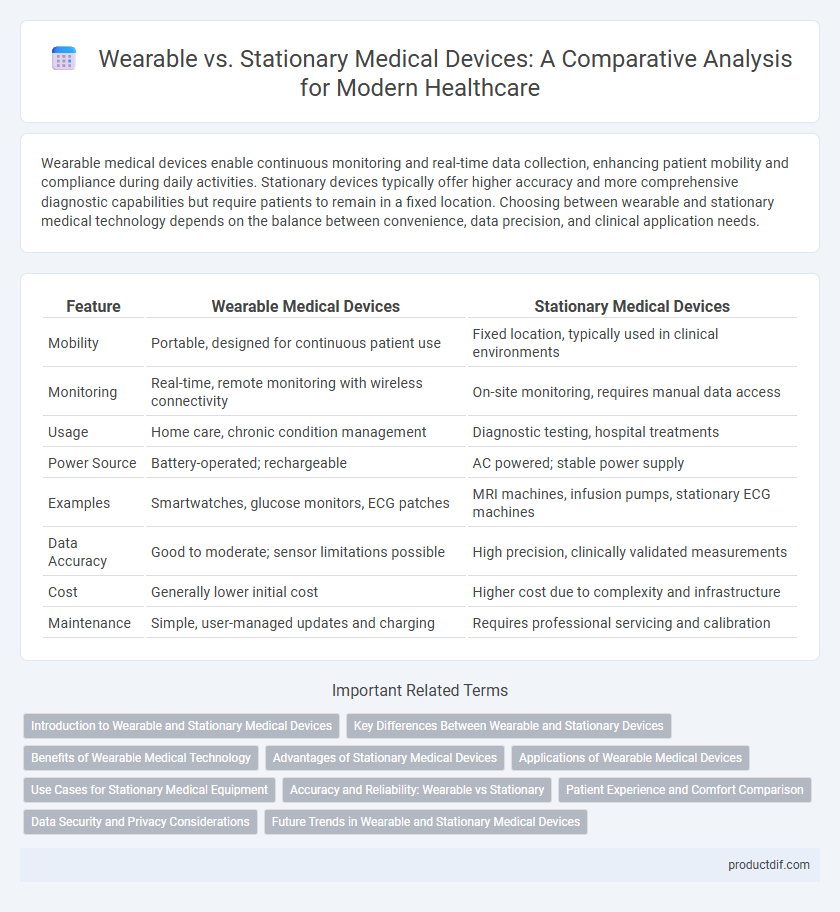Wearable medical devices enable continuous monitoring and real-time data collection, enhancing patient mobility and compliance during daily activities. Stationary devices typically offer higher accuracy and more comprehensive diagnostic capabilities but require patients to remain in a fixed location. Choosing between wearable and stationary medical technology depends on the balance between convenience, data precision, and clinical application needs.
Table of Comparison
| Feature | Wearable Medical Devices | Stationary Medical Devices |
|---|---|---|
| Mobility | Portable, designed for continuous patient use | Fixed location, typically used in clinical environments |
| Monitoring | Real-time, remote monitoring with wireless connectivity | On-site monitoring, requires manual data access |
| Usage | Home care, chronic condition management | Diagnostic testing, hospital treatments |
| Power Source | Battery-operated; rechargeable | AC powered; stable power supply |
| Examples | Smartwatches, glucose monitors, ECG patches | MRI machines, infusion pumps, stationary ECG machines |
| Data Accuracy | Good to moderate; sensor limitations possible | High precision, clinically validated measurements |
| Cost | Generally lower initial cost | Higher cost due to complexity and infrastructure |
| Maintenance | Simple, user-managed updates and charging | Requires professional servicing and calibration |
Introduction to Wearable and Stationary Medical Devices
Wearable medical devices are compact, portable tools designed to monitor physiological metrics such as heart rate, glucose levels, and activity in real-time, enabling continuous health tracking outside clinical settings. Stationary medical devices, commonly found in hospitals and clinics, provide comprehensive diagnostic and therapeutic functions, including imaging systems, ventilators, and dialysis machines, requiring fixed installation. Both device types play critical roles in patient care by balancing mobility with advanced clinical capabilities.
Key Differences Between Wearable and Stationary Devices
Wearable medical devices offer continuous, real-time health monitoring through compact sensors integrated into clothing or accessories, enabling patient mobility and immediate data collection. Stationary devices, typically larger and fixed in one location, provide comprehensive diagnostic capabilities with higher power and processing capacity, often used in clinical settings for detailed analysis. The key differences lie in portability, data immediacy, and application scope, with wearables favoring ongoing health tracking and stationary devices supporting advanced diagnostics.
Benefits of Wearable Medical Technology
Wearable medical technology offers continuous, real-time monitoring of vital signs, enabling early detection of health abnormalities and improving patient outcomes. Portable devices enhance patient mobility and compliance by providing convenient and unobtrusive health tracking outside clinical settings. Advanced sensors and wireless connectivity in wearables facilitate personalized treatment plans through seamless data integration with healthcare providers.
Advantages of Stationary Medical Devices
Stationary medical devices offer enhanced precision and stable power supply, ensuring consistent performance during critical diagnostics and treatments. Their larger size allows integration of advanced sensors and imaging technologies, providing comprehensive data for accurate patient monitoring. These devices also support continuous operation without battery limitations, making them ideal for long-term clinical use in hospitals and specialized healthcare settings.
Applications of Wearable Medical Devices
Wearable medical devices enable continuous monitoring of vital signs, such as heart rate, blood pressure, and glucose levels, facilitating real-time health management and early detection of medical conditions. Their portability and non-invasive nature support chronic disease management, fitness tracking, and remote patient monitoring in diverse settings outside traditional healthcare facilities. Integration with mobile apps and cloud platforms enhances data accessibility and personalized healthcare interventions, driving improved patient outcomes.
Use Cases for Stationary Medical Equipment
Stationary medical equipment commonly serves in hospital settings for continuous patient monitoring, such as MRI machines and dialysis units that require fixed installations. These devices provide high precision and stability, essential for complex diagnostics and treatments that demand consistent power sources and environmental controls. Stationary equipment supports intensive care and surgical environments where mobility is limited but accuracy and reliability are critical.
Accuracy and Reliability: Wearable vs Stationary
Wearable medical devices offer continuous monitoring but may experience variability in accuracy due to movement artifacts and sensor placement. Stationary medical devices typically provide higher reliability and precision owing to controlled environments and stable positioning. Clinical studies show stationary devices often outperform wearables in measurements requiring stringent accuracy, such as electrocardiograms and blood pressure monitoring.
Patient Experience and Comfort Comparison
Wearable medical devices offer enhanced patient comfort by enabling continuous monitoring without restricting mobility, which improves adherence and real-time health tracking. Stationary devices, while often providing more comprehensive data through fixed settings, can limit patient freedom and cause discomfort due to prolonged immobility during use. Optimizing patient experience involves balancing the convenience of wearables with the accuracy and stability of stationary equipment in clinical applications.
Data Security and Privacy Considerations
Wearable medical devices pose unique data security challenges due to their continuous data transmission and exposure to varied wireless networks, increasing vulnerability to unauthorized access and breaches. Stationary medical devices, often secured within controlled environments, benefit from more robust physical protections but still require advanced encryption protocols and regular software updates to safeguard patient information. Implementing stringent authentication measures, data anonymization, and compliance with regulations like HIPAA and GDPR is essential for both device types to ensure optimal privacy and data integrity in healthcare settings.
Future Trends in Wearable and Stationary Medical Devices
Future trends in wearable medical devices emphasize enhanced real-time health monitoring through advanced biosensors and AI-driven analytics, enabling personalized treatment plans. Stationary medical devices are evolving with improved integration of IoT connectivity and automation, facilitating remote diagnostics and streamlined hospital workflows. The convergence of wearable and stationary technologies aims to create comprehensive healthcare ecosystems for continuous patient care and data-driven decision-making.
Wearable vs Stationary Infographic

 productdif.com
productdif.com